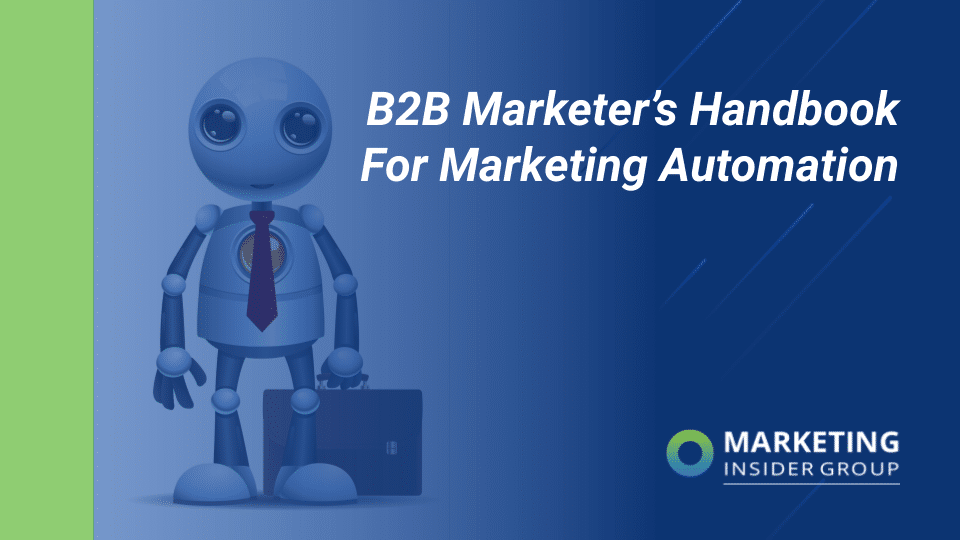
The B2B Marketer’s Guide to Creating Irresistible Lead Magnets
So you’re a B2B marketer. You know the ins and outs of what makes your product awesome. You’ve spent countless hours developing content for potential buyers. You’re sure once they visit your website, they’ll be convinced they can’t live without what you’re offering.
Sound right?
If it does, we’ve got to be honest: no matter how great your product is, your content isn’t going to capture many leads on its own. In fact, 70% of your website visitors will visit once and never return.
Buyers are savvy, and they don’t want to dole out their contact information without getting something tangible in return, even if they like your brand and your content.
In short: you’re not as irresistible as you think.
But your lead magnets? They can be.
Quick Takeaways:
- Lead magnets should always be high-value, specific, actionable, and accessible.
- The most effective lead magnets offer valuable content and still leave your potential buyer wanting more.
- Checklists, product demos, webinars, e-books, and whitepapers are some of the most popular types of B2B lead magnets.
- B2B marketers and sales teams must collaborate to implement a lead magnet follow-up plan.
What Are Lead Magnets?
Lead magnets are free content you give your website visitors in exchange for their contact information.
In a nutshell, whenever a prospect lands on your website, your end-goal is to drive profitable action. But visitors are seldom ready to make purchase decisions right away. That’s where lead magnets come in.
B2B lead magnets are high-value assets offered by companies in exchange for a potential buyer’s contact information. They’re typically used during to capture customers early on in their journey, when buyers are researching their problem and checking out potential solutions. Lead magnets offer your visitors something in addition to your regular website content. When used effectively, they can increase opt-in rates by 85%.
When you use lead magnets, you grant them access to gated content, and in return, they fill out a signup form on your site. And voila! You just got them to join your email list, which can make it a whole lot easier for you to engage with and convert them into future buyers through email marketing.
Think of lead magnets as a reward for opening a dialogue and engaging with your brand.
But it’s not as easy as offering extra blog content or more details on your product. In order to drive conversions, lead magnets have to offer real value to potential buyers and ideally help them accomplish something meaningful so they see the benefit of working with your company.
Who Needs Lead Magnets?
You’d do well to create and use lead magnets if you are
trying to initiate interaction with leads and prospects
The vast majority of first-time visitors aren’t ready to buy. Rather, they’re more likely just looking around as they shop for options. Maybe they’re doing some product research. Maybe they’re just interested in an educational infographic you published.
But you can’t give up just yet and let your prospect slip away. The simple act of browsing your site is a promising indication that sooner or later, they might become a customer.
While they’re at this stage of the buying process, you can take the opportunity to offer free content. It’s a good way to connect with your leads, especially when you’re able to give them something valuable and relevant in a content format that appeals to them.
Your free offer can also help you build a sense of confidence, trust, and authority amongst your sales prospects. It’s a gesture that reflects serious efforts from your end to provide “real” value.
looking to generate more qualified leads
Lead magnets are particularly useful for your content marketing team if your focus is on the quality of leads and not quantity. Gated content is not available for everyone, but anyone who wants it enough will be willing to share their personal information with you. (This includes their name, email address, occupation, company, annual revenue, and anything else that helps your sales team personalize and improve their communications).
By getting these details, you can paint a better picture of these prospects, and in the future, you can also take advantage of qualitative information to craft better lead magnets that are more attractive to your target audience segment.
Gating your content might lead to a reduction in traffic and page views, but you can pretty much guarantee that the users who do end up viewing your content will be better in terms of quality and relevance to your product offering.
Lead Magnet Examples for B2B Marketers
Now that we know the traits of an irresistible lead magnet, let’s talk about some of the most popular types of lead magnets for B2B marketers specifically.
Unlike in the B2C world, B2B lead magnets are not about instant gratification. This is because B2B buyers aren’t about instant gratification — they’re looking for a solution that will require a serious investment from their company, and they’re willing to put in the time to learn how your product can be valuable to them.
Don’t shy away from high-level language or lots of detail. B2B buyers are looking for expertise, and your lead magnet should show them that you have it.
Here are some of the most popular types of lead magnets used by B2B marketers.
PDF Checklists
Checklists and guides get people motivated and help them feel organized. They can also take a complex problem or solution and make it more manageable.
Checklists can help your potential buyer feel like they have a better understanding of both their problem and the solution you can provide. Here’s a good B2B example from AutoGrow:
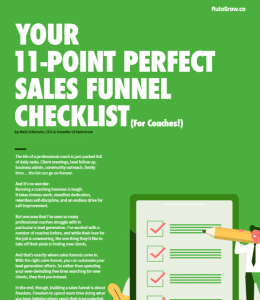
Quizzes
For digital users with short attention spans, sometimes it’s worth considering interactive content that forces users to engage. Enter the quiz lead magnet, where you provide some form of assessment or test and interpret the result of their answers at the end.
For example, young parents might want to take a quiz to know if their parenting style might be too restrictive or too liberal for their children. Since it’s natural for parents to want to know whether they’re raising their kids right, it’s almost a guarantee that they’ll be inputting their email address to get a copy of the test results.
E-Books and Whitepapers
E-books and whitepapers can both be used to demonstrate your industry expertise. Both are educational; the main difference between them is the expertise level of the potential buyer.
E-books are written for non-experts and include introductory, educational content. Whitepapers are more academic and provide an in-depth analysis of a very specific topic. E-books are more approachable in general, but whitepapers are often better for highly regulated or technical industries. People love eBooks because they’re easy to download, save, and read, especially those in PDF format.
Your eBook could be something as simple as a PDF version of a blog post so users can download it for offline reference at a later point. Online users don’t always have the time to read long-form articles, so offering a “takeaway” version can sometimes be enough to compel prospects to sign up.
On the other hand, you can also create a comprehensive whitepaper that’s related to a particular blog post but offers more detailed actionable tips. You can then use it as a content upgrade so users can choose to sign up if they’re interested in the blog post and want to learn more about the topic.
Here are two examples that show the depth differential between e-books and white papers.
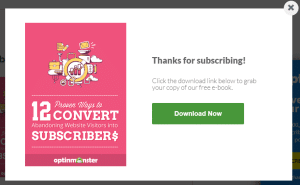
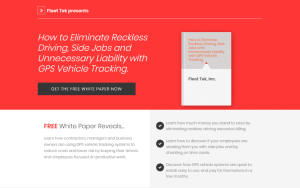
Cheat Sheets
Everybody loves cheat sheets because they save people a lot of time by cutting to the chase. They work similarly to a checklist, only cheat sheets have a more actionable nature to them.
Cheat sheets are especially useful if you’re sharing tips that help readers understand complex tasks for the first time. A good example of this type of content might be “A Handy Cheat Sheet for Beginning Ad Writers.”
When developing a cheat sheet, always remember to keep things brief and concise. It’s not about telling a story; it’s about getting straight to the value of your content.
Coupons
If you’re trying to drive sales on your ecommerce store, free coupons can be highly-effective lead magnets. By offering discounts, you’re creating a sense of exclusivity, giving prospects more incentive to make purchase decisions. Further, instill a sense of urgency by making your discount offer limited. This usually creates enough “fear of loss” to drive initial purchases.
Airlines, travel agencies, fashion stores, food and beverage companies, and other retail businesses are more likely to offer free coupons because of the high price sensitivity of their markets.
Free Trials
A free trial is a very logical offer for your sales leads. By signing up for a free trial to, say, a SaaS tool, your leads can see how your product works first hand and determine if it’s something that can be integrated into their operations.
These factors are helpful as your potential customers decide to continue with the purchase down the road. You should also design your free trial lead magnet with an email workflow that follows-up when leads don’t convert into buyers after the trial period expires.
Demo Videos or Webinars
Video content is always a winner — it consistently beats out all other types of visual content when rated by consumers. Video is great for B2B marketing because it can be educational without being boring.
Two of the most effective strategies for using video lead magnets are product demos, which allow potential buyers to see your product in action, or webinars, which demonstrate thought leadership and connect buyers to real people at your company.
Webinars are usually highly anticipated and well received because prospects want to learn from the experts. Their interactive nature and opportunity for learning make them highly sought after and are often the highest-converting lead magnet formats.
One of the most important things to keep in mind with webinars is to engage and interact with your audience. Remember, you’re doing this for them, not your brand. Relevant interactions create even more value for your audience, so the more you’re able to engage, the more likely your webinar will be a success.
To further enhance your webinar’s magnetism, offer it live as well as via a pre-recorded video so your prospects can view it at their own convenience. Not everyone operates in the same time zones and working hours.
Here’s an example from Kapost that includes a strong value proposition (learning from world-class marketers) and a clear description of what you’ll get from the content (webinar highlights).
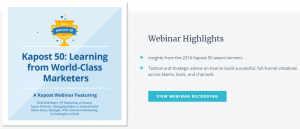
Traits of an Irresistible Lead Magnet
High Value
Lead magnets should have higher value than the regular content you offer on your website. This doesn’t mean your web content isn’t high-value, too. It just means that your lead magnets offer something more.
Think of it like this: if you were a potential client reading your content, what would you want next?
If your website offers an overview of your product, your lead magnet could offer a full product demo video. If one of your blog posts gives tips for creating an effective marketing plan, your lead magnet could be a downloadable marketing plan template.
Lead magnets offer value by both enhancing the public content you publish on your website and giving your client something applicable to their job and company — ideally, something that helps solve the original problem that led them to you in the first place.
Specific
Let’s go back to one of our original points: buyers are savvy, and they don’t want to give companies their contact information unless they’re getting something tangible in return.
Vague suggestions of “more details” or “frequent updates” or “learning more” won’t get it done for B2B buyers who are trying to accomplish important goals for their companies.
When you’re using lead magnets, be specific about what they offer. Give your potential buyers details about what they’ll be receiving, both in terms of content and value.
- Good lead magnet teaser: Download our proven 10-step checklist for creating high-converting B2B webinars!
- Not-so-good lead magnet teaser: Subscribe to our newsletter for more B2B sales tips!
Accessible
Don’t make potential buyers jump through hoops to access your lead magnet content. Deliver what you promise and do it quickly — after all, this is their first impression of what it will be like to work directly with your company.
It’s great if you can offer an instant download link after buyers share their contact information so that they don’t even have to leave the webpage to get access.
If you’re emailing the content, give clear information about the delivery time and make it as quick as possible. Instant email delivery (or within a few minutes) is best so you don’t give your potential buyer time to lose interest or move on to researching other options.
Actionable
We talked about making your lead magnet content applicable to your potential buyers, meaning they’ll learn something they can actually use. Even better is to make your lead magnets actionable, meaning they help your buyer do something that improves their lives and adds value for their company.
Let’s revisit our two previously mentioned lead magnet examples: the product demo and the marketing plan template.
The marketing plan template is the more actionable of the two here; it gives potential buyers the ability to take what they’ve learned from your content and apply it to a plan they can actually implement at their company. At the same time, they get to know the kinds of strategies and tools your company provides.
The product demo is more informational. It’s going to add value because buyers can see how your product works and understand how they’ll use it, but there’s no real action on the part of the buyer.
In this case, you’d want to think about how to enhance your product demo lead magnet so it’s both informational and actionable. One way might be to end the demo with an opportunity for clients to try out your product through a free trial. If free trials aren’t possible with your product, you could include a clear call to action for buyers to schedule a free consultation.
In the end, making your lead magnets actionable means increasing your potential buyer’s time investment in your company.
Use Your Lead Magnets Wisely
Research says that when you give your subscribers a good idea of the kind of content they’re signing up for, the opt-in rate can rise by almost 85%.
Here are the stats:
- 9 out of 12 of LeadPage’s highest-converting lead magnet templates come from webinar registration pages.
- 80% of business leaders and decision makers choose to get company information through a series of articles instead of an advertisement.
- Organic search leads enjoy a 14.6% close rate compared with outbound marketing’s 1.7%.
You probably won’t want to gate all the content on your website because that will likely have a negative effect on traffic. It’s always a good idea to build up a healthy balance of gated and ungated content, so you’re still making the most of content marketing for SEO while saving your best content for those that really want it.
The best lead magnets provide something valuable, specific, accessible, and actionable — but they should still leave potential buyers wanting more. In other words, when they finish interacting with your lead magnet content, they should still feel like they need your company to solve their problem.
Let’s apply this idea to our product demo and marketing plan examples. This time, it’s the product demo that does the job naturally. After watching the video, your potential buyer knows how your product is valuable, but they can’t do anything about it without actually buying the product (or scheduling that free consultation).
The marketing plan template is a different story. In this case, you might want to think about how you can thread your product into the template to emphasize its necessity.
For instance, if you’re selling an email marketing system, you’d want to be sure there are clear steps in that marketing plan template for launching an email campaign. This way, your potential buyer can make their plan, but they can’t implement it without your product.
Check out this great 3-step tutorial for a deeper dive into building lead magnets that will leave potential buyers wanting more from your company.
Close the Loop
Finally: don’t just send your lead magnet out into the world and hope for the best.
Even after sharing their contact information in exchange for your lead magnet, it’s not a sure thing that potential buyers will reach out to you to move forward. It’s on you to follow up.
For B2B marketers, this usually requires working with your sales team so that they understand the marketing strategies being implemented and have a strong follow-up plan in place.
To sum up, using lead magnets is key to your marketing strategy if you’re looking to build a relevant contact list and establish a relationship with your prospective customers. Email marketing is still delivering the highest ROI of any other channel, so the quality and size of your contact list are extremely important.
Both you and your leads stand to benefit from lead magnets: you give your leads content that they want for free, and you get the contact information you need for your lead email campaigns. But before going out and creating a lead magnet, you should always ask yourself this question:
What can I give away for free that will make my prospective customers’ lives better?
If you have an answer for that, you’ve got yourself a great idea for a lead magnet!
Ready to create lead magnet content that converts? Marketing Insider Group can help! Schedule a free consultation today to learn more!


